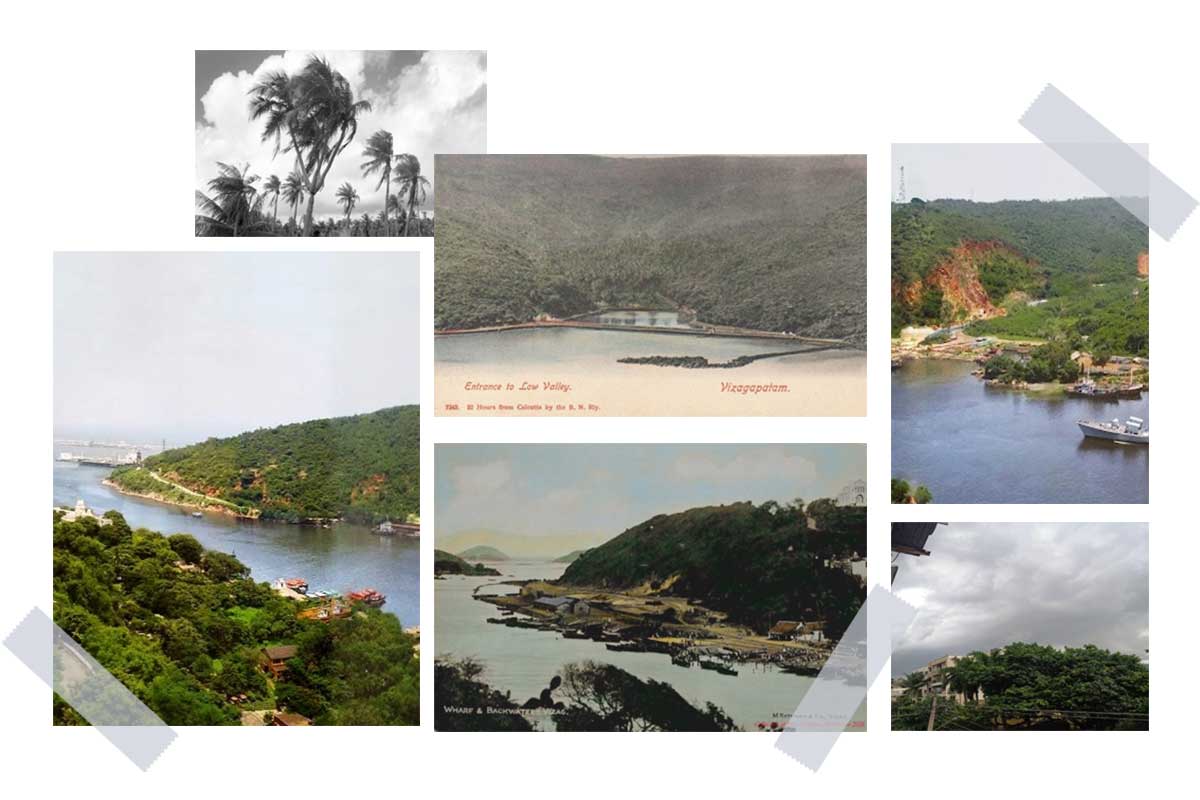

Image Credits: John Castellas
Nestled in a valley of the Yarada Konda range across the entrance to Vizag’s harbour, a picturesque garden was nurtured by its owner – Maharajah Sir Goday Narayan Gajapathi Rao until the construction of the Vizag harbour in the 1920s resulted in the land being compulsorily acquired by the port authority. Called Low Valley by some and Lower Gardens by others, the name has its origins with the Telugu Lova Thota that was a popular picnic spot for generations of Vizag folk.
The Madras Weekly Mail of 20 March 1889 provides an eloquent description of Lova Thota in Vizag:
“…its scenery being of a unique specimen. On one side of the backwater are the port buildings and bazaar, but on the other side the rocks come down to the waters edge leaving only a small causeway at the bottom. If, after being ferried across, you follow this causeway you presently come to a narrow rift in the hills which leads to a long narrow valley behind the Dolphin’s Nose. Although it is so close to the busy town yet it is so well hidden away amongst the hills, and so different to anything one would expect in such a vicinity, that after once entering the valley, one feels in a world apart. The valley is also confined by high hills covered in thick jungle, which rise abruptly on both sides. The valley is half-jungle and half garden, combining the natural beauty of Tempe with the cultivated luxuriance of a garden of Hefuz. A natural stream of pure water, which rises up in the hills at the top, and, after falling into the bosom of the valley in a beautiful cascade – the prettiest and shadiest spot in all this beautiful garden – trickles down the centre, and by means of artificial reservoirs and lotus covered banks, the water is caught and distributed over the gardens by masonry aqueducts. The gardens are terraced, and filled with a wonderful variety of trees, shrubs and flowers; the full glare of sunlight never penetrates the thick foliage, and one may saunter along the various pathways in coolness and comfort even when old Sol is in his hottest mood.
Silence and twilight here, twin sisters keep
Their noonday watch, and sail among the shades
Like vaporous shapes, half seen.
The groves of rustling palms, the dark green orange trees, the pomegranate trees with their glossy leaves and flame coloured flowers, the flowering jasmines, the luxuriant roses bending beneath their loads of flowers, all unite their blooms and fragrances, while here and there as huge umbrella shaped almond tree, or a hoary old banyan, towers above them with far protruding branches. It is with regret that we leave such a Garden of Eden, and after being ferried across the backwater the port seems noisier and the streets dustier that we left them about an hour or so ago…”
Records show that, in the mid-1800s, the Governor of Madras Presidency and Maharajah of Travancore were residential guests of Maharajah Gajapathi Rao at his handsome Bungalow and Summer House. A Cheetah had lived in his cage there, and at times, sport was afforded by wild pigs. The Maharajah permitted free use of the gardens and the bungalow to picnickers. Occasionally, visitors would be ferried across the backwater by moonlight to picnic under the stars of a clear balmy Vizag night sky. There was a drawback – mosquitoes! This was the justification for the Government acting to compulsorily acquire the land despite legal challenges at the highest courts.
The Yarada villagers were said to be the only beneficiaries of the abundant fruit and clean freshwater of the gardens. Vizag town provided the villagers with a source of income from the sale of fresh produce but no trade was more popular than a guided tour to the legendary coconut tree of Lova Thota.
It is said that deep in the Low Valley, lay the mystical Four-Fronded Coconut tree and the local belief was that good fortune was bestowed on those who visited the tree. To drink its coconut water was regarded as a cure-all and villagers were happy to make a small earning from selling their coconuts.
When the Low Valley was legally valued down as no more than a mosquito infected backwater that threatened the health of the workers in the new Vizag harbour, little would Vizag citizens of yesteryear realise that their Garden of Eden would become a port construction site or that its coconuts groves with their ‘nectar of the Gods’ would become the home of the new age nectar – strategic oil reserves!
Should you have an anecdote or a piece of history of Vizag that you’d like to share, the author would appreciate you contact him at jcastell@ozemail.com.au
Written by John Castellas whose family belonged to Vizag for 5 generations. Educated at St Aloysius, migrated to Melbourne, Australia in 1966, former General Manager Engineering at Boeing & Qantas Airways, in retirement Lecturer in Aviation Management at Swinburne University and is a Vizag aficionado.
Karate Kid: Legends, the sixth instalment in the Karate Kid franchise, has hit theatres and…
The weekend has officially begun! With the start of a fresh Friday evening comes the…
Most people know they should save for retirement. But when it comes to how much,…
Vizag-origin filmmaker, Sagi Sree Hari Varma, will start a remarkable journey to Italy to participate…
An elderly 64-year-old man from HB Colony in Visakhapatnam passed away shortly after testing positive…
Yoga training sessions are being conducted by the district administration at the ward secretariats in…
Leave a Comment